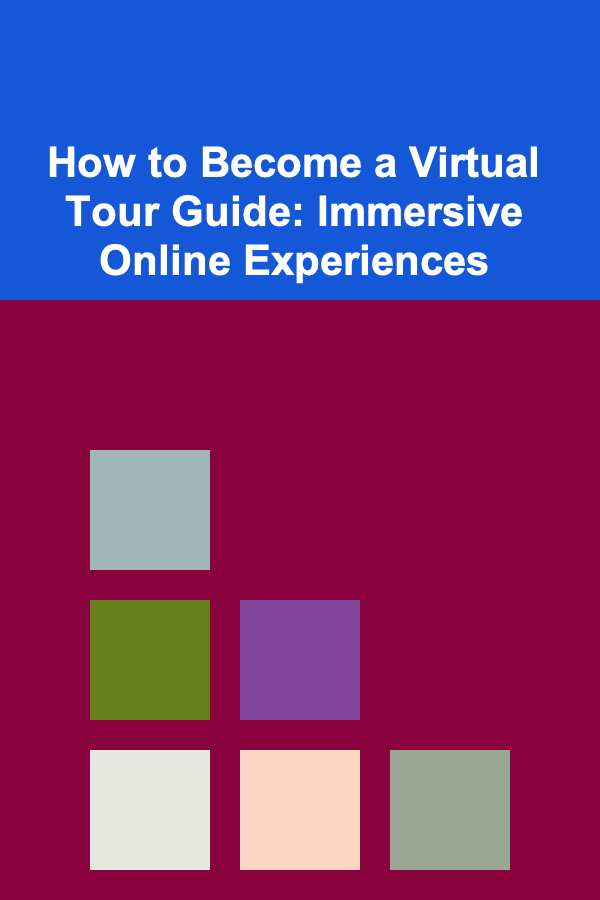
How to Become a Virtual Tour Guide: Immersive Online Experiences
ebook include PDF & Audio bundle (Micro Guide)
$12.99$7.99
Limited Time Offer! Order within the next:

The world is rapidly changing, and with it, the ways we experience and interact with various destinations. Virtual tours have become increasingly popular as they offer people from all over the world an opportunity to explore new locations, historical landmarks, or even art galleries from the comfort of their homes. As technology continues to improve, these experiences are becoming more immersive, engaging, and interactive. This shift has opened up an entirely new realm of possibilities for those looking to become virtual tour guides.
In this article, we will explore how to become a virtual tour guide, the necessary skills and tools you need, and tips on creating immersive online experiences that captivate audiences. Whether you are an expert on a specific city or passionate about showcasing the wonders of a museum, this guide will help you navigate the exciting world of virtual tourism.
Understanding the Virtual Tour Landscape
Before diving into the specifics of becoming a virtual tour guide, it's essential to understand the growing demand for virtual travel experiences. Virtual tours have gained immense popularity due to the accessibility they offer to a global audience. Here are a few key factors contributing to this growth:
- Increased Accessibility: Virtual tours break down geographical barriers, allowing anyone with an internet connection to explore new places.
- Pandemic Influence: The COVID-19 pandemic accelerated the adoption of virtual tourism, as many people were unable to travel in person. As a result, many people turned to virtual experiences to explore the world.
- Interactive and Engaging Content: Modern virtual tours often incorporate interactive features like 360-degree views, live guides, and multimedia elements to enhance the experience.
- Niche Markets: Virtual tours can cater to niche markets such as historical landmarks, adventure tourism, or even niche hobbies like architecture or wildlife.
With this backdrop, becoming a virtual tour guide offers numerous opportunities, whether you're leading virtual tours of a city, a museum, or even specialized niche tours such as architectural walks or wine-tasting sessions.
Core Skills for a Virtual Tour Guide
A virtual tour guide needs a variety of skills to ensure their tours are informative, engaging, and interactive. While the specific skills may vary depending on the type of tour you're conducting, there are several core competencies that every virtual tour guide should develop.
2.1. Communication Skills
Being able to clearly and effectively communicate information is at the heart of being a successful tour guide. You need to engage and inform your audience, keeping them entertained while providing valuable insights. Strong verbal communication skills are essential, and you should be able to adapt your tone and style to suit the audience, whether you're guiding children through a museum or discussing intricate historical events with adults.
2.2. Storytelling Ability
Great tour guides are excellent storytellers. It's not just about giving facts---it's about crafting a narrative that hooks the audience. Being able to tell stories related to the destination, its history, culture, and significance will make your virtual tours far more engaging and memorable.
2.3. Technical Proficiency
Since you'll be conducting tours online, it's vital to have a basic understanding of the technical tools required for virtual tours. This includes knowing how to use video conferencing software (such as Zoom, Microsoft Teams, or Google Meet), virtual tour platforms (like Google Arts & Culture or 360-degree tour software), and any hardware you may need (cameras, microphones, etc.).
2.4. Knowledge of the Subject Matter
Whether you're leading a historical walking tour in Rome, an art tour in Paris, or a nature walk through a national park, your expertise is key. You should have a deep understanding of the places or topics you're guiding on. Extensive research and preparation will ensure you're able to answer questions from participants and provide them with in-depth knowledge.
2.5. Interpersonal Skills
Being a virtual tour guide means interacting with people, often in real-time. Developing interpersonal skills such as patience, empathy, and attentiveness is essential for managing different types of audience members, especially when you're guiding groups online.
2.6. Multimedia and Visual Skills
Virtual tours often incorporate multimedia elements like images, videos, and 360-degree photos. A tour guide who can effectively use these visual aids will create a richer and more engaging experience for participants. Understanding how to use presentation software, create or edit multimedia content, and incorporate virtual tour tools is a plus.
The Tools and Equipment You Need
To become a virtual tour guide, you'll need the right equipment to provide an immersive and seamless experience for your audience. While the specific tools will depend on the type of tour you're conducting, the following are essential for most virtual tour guides.
3.1. A Reliable Camera
A good camera is crucial for offering high-quality visuals, especially for virtual tours that involve live interactions or recorded experiences. Many virtual tours now involve 360-degree photography or video, which requires specialized cameras. However, if you're starting out with simpler video-based tours, a good quality webcam or DSLR camera will suffice.
3.2. Microphone and Headset
Clear audio is just as important as clear visuals when conducting a virtual tour. Invest in a high-quality microphone or headset to ensure your voice is crisp and easy to hear. Poor sound quality can quickly drive participants away.
3.3. Live Streaming Platforms
You'll need access to live streaming or video conferencing platforms to host your virtual tours. Tools like Zoom, Skype, or specialized virtual tour platforms such as 360Cities or VeeR can help you stream and engage with participants in real-time.
3.4. Tour Software and Apps
For immersive virtual experiences, many virtual tour guides use specialized platforms that allow users to experience 360-degree views or interactive elements. Platforms like Google Arts & Culture, Virtual Tours, and AirPano offer opportunities to create and share virtual tours.
3.5. Editing Software
If you're recording virtual tours for later viewing, editing software is essential for cutting together clips, adding music, captions, or other engaging elements. Programs like Adobe Premiere, Final Cut Pro, or iMovie can help you create polished content that looks professional.
3.6. Internet Connection
Having a stable and fast internet connection is essential for live virtual tours. Any lag or disruption can significantly affect the experience. Ensure that your setup allows for smooth streaming without technical issues.
How to Create Immersive Online Tour Experiences
Creating immersive virtual experiences involves more than just showing your audience a location---it's about making them feel like they're really there. Here are some strategies to ensure your online tours are as immersive as possible.
4.1. Use 360-Degree Videos
One of the most popular tools for creating immersive virtual tours is the 360-degree video. This technology allows participants to look around as if they were physically present in a location. By using 360-degree cameras, you can give your audience an authentic and fully immersive experience.
4.2. Interactive Elements
Engage your audience with interactive features. You can add clickable hotspots in 360-degree tours where participants can click to learn more about specific objects, landmarks, or points of interest. This interactivity helps keep participants engaged.
4.3. Live Commentary and Q&A
While pre-recorded virtual tours are an option, many virtual tour guides prefer to offer live commentary to provide a personal touch. Offering live Q&A sessions after the tour allows participants to ask questions and engage with you, making the experience feel more authentic.
4.4. Use of Visuals and Audio
Enhance your storytelling by incorporating multimedia elements such as historical photos, videos, or music that tie into the location you're touring. For example, if you're giving a virtual tour of the Eiffel Tower, you could show a time-lapse video of the tower at night or share a recording of the French national anthem.
4.5. Consider the User Experience
Think about your audience's experience from start to finish. Make sure the navigation is simple and that the pacing of your tour is just right. If it's too fast, you may lose their attention; if it's too slow, they might get bored. Balance your content and delivery for the best experience.
Marketing Your Virtual Tour Services
Once you've honed your skills and set up your equipment, it's time to get your name out there. Marketing your virtual tour services is key to attracting clients and building a loyal audience. Here are some tips for marketing your virtual tour services:
5.1. Create a Website or Portfolio
Having a website that showcases your tours, offers details on upcoming events, and includes testimonials from satisfied clients can help establish your credibility. Include high-quality videos, samples of your tours, and details on how to book.
5.2. Leverage Social Media
Social media platforms like Instagram, Facebook, and TikTok are powerful tools for promoting your tours. Share short clips from your virtual tours, behind-the-scenes content, and engage with followers to build an audience.
5.3. Offer Free or Discounted Trials
To attract new clients, consider offering a free or discounted trial of your virtual tour. This gives potential clients a taste of your style and expertise without any commitment.
5.4. Collaborate with Other Guides or Platforms
Partnering with other virtual tour guides or tour platforms can help you expand your reach. You can co-host tours, promote each other's content, or appear on established platforms that already have a large following.
Conclusion
Becoming a virtual tour guide offers exciting opportunities to share your expertise and passion with a global audience. By mastering the essential skills, using the right tools, and creating immersive and engaging experiences, you can build a successful virtual tour business. Whether you're guiding tourists through ancient ruins or showcasing modern art, your knowledge and creativity will shine through and leave a lasting impression on your virtual audience.
Reading More From Our Other Websites
- [Home Party Planning 101] How to Plan a Kid-Friendly Party That Adults Will Enjoy Too
- [Home Maintenance 101] How to Respond to Common Building Code Violations During Home Renovations
- [Polymer Clay Modeling Tip 101] Mastering Texture: Pro Tips from Top Polymer Clay Artists
- [Home Cleaning 101] How to Clean Your Microwave with Lemon: The Natural and Effective Way to a Fresh-Smelling Kitchen
- [Personal Care Tips 101] How to Layer Foundation and Concealer for Maximum Coverage
- [Paragliding Tip 101] Aspect Ratio Explained: Balancing Speed and Stability in Your Paraglider
- [Home Renovating 101] How to Select the Best Materials for Your Renovation
- [Home Soundproofing 101] How to Stay Informed About the Latest Soundproofing Innovations
- [Personal Care Tips 101] How to Choose the Best Face Mask for Acne Scarring
- [Home Staging 101] How to Implement Unique Curb Appeal Ideas for Home Staging That Go Beyond Landscaping

How to Become a Social Media Manager: A Complete Guide
Read More
How to Maintain Your Home's Exterior to Boost Curb Appeal
Read More
How to Save on Energy Costs by Implementing Budget-Friendly Solutions
Read More
How to Save on Home Insurance Without Compromising Coverage
Read More
Mastering Content Strategy: A Roadmap for the Modern Content Strategist
Read More
How To Understand the Impact of Streaming on Music
Read MoreOther Products

How to Become a Social Media Manager: A Complete Guide
Read More
How to Maintain Your Home's Exterior to Boost Curb Appeal
Read More
How to Save on Energy Costs by Implementing Budget-Friendly Solutions
Read More
How to Save on Home Insurance Without Compromising Coverage
Read More
Mastering Content Strategy: A Roadmap for the Modern Content Strategist
Read More